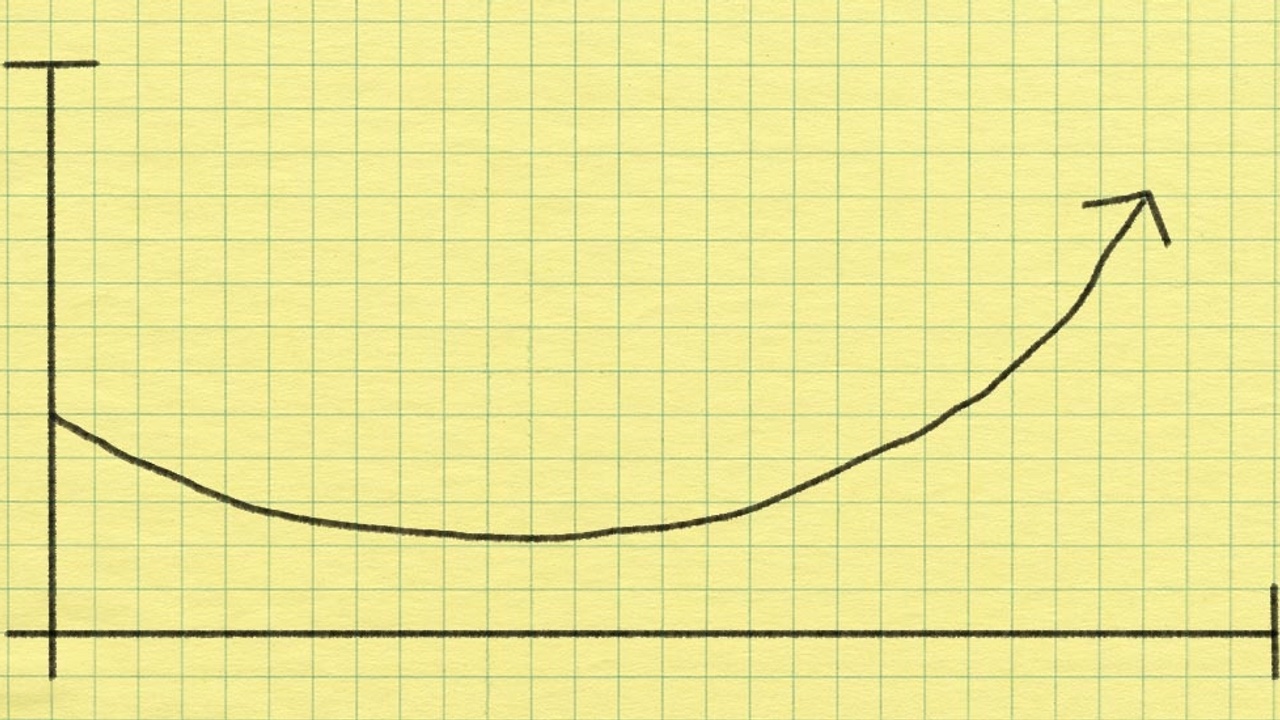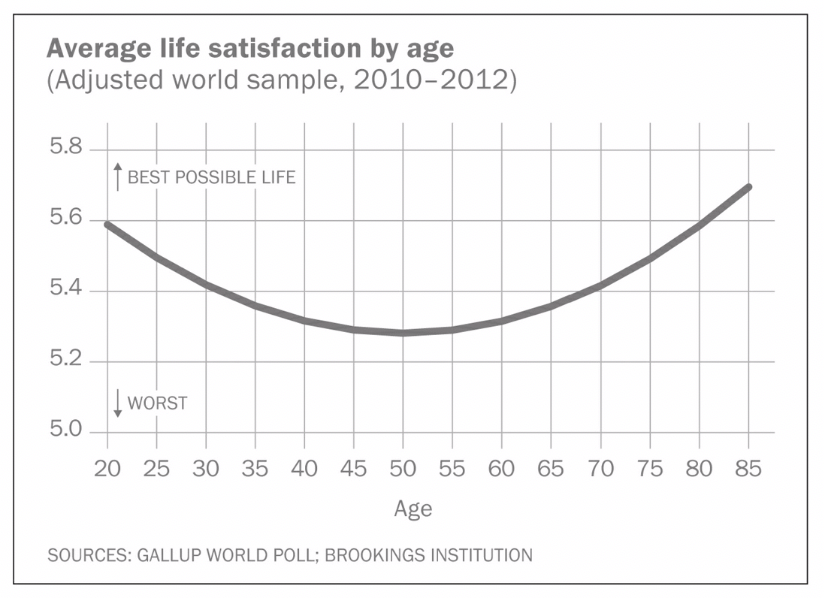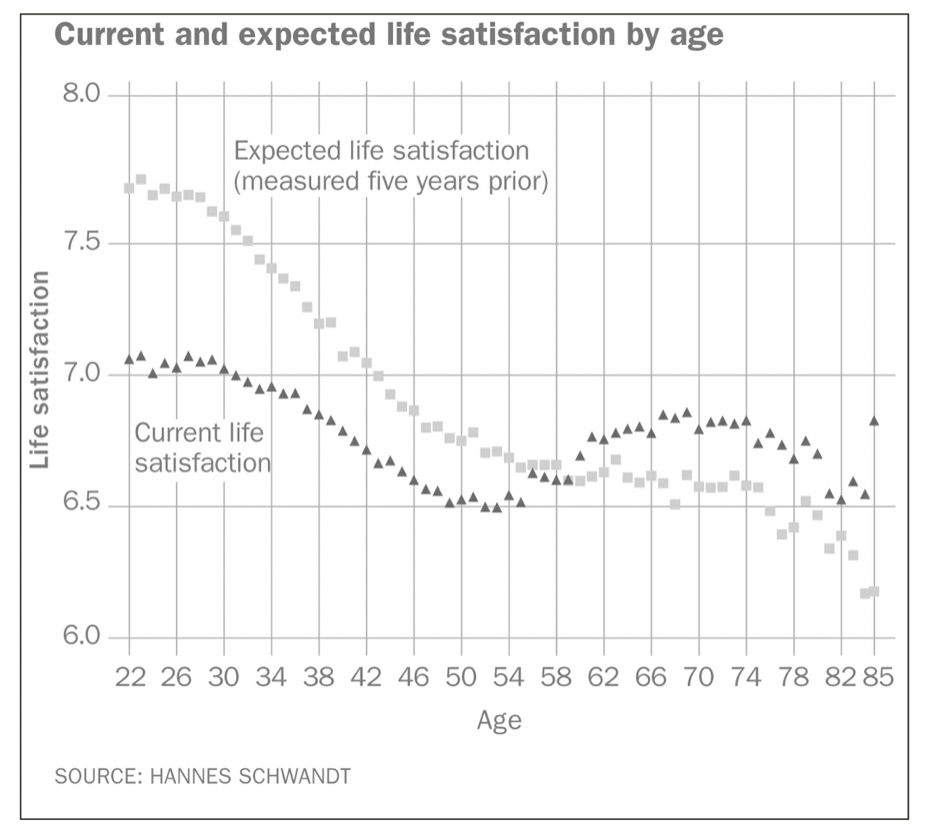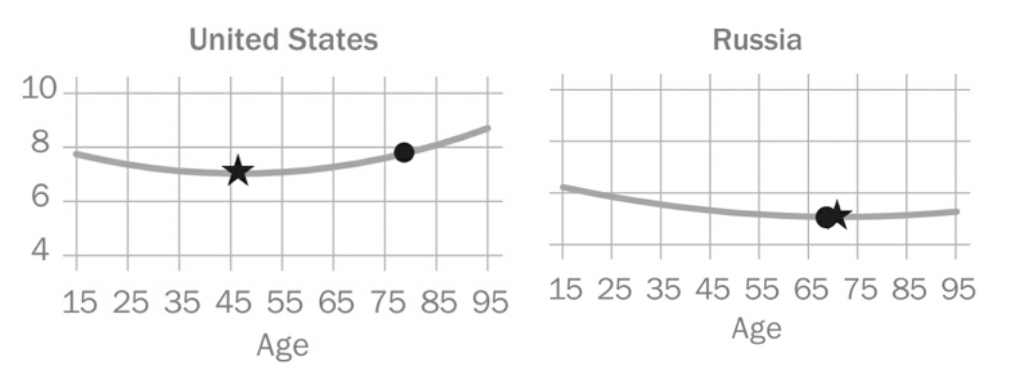The Little Known Happiness Curve
Feb 21, 2019
The U-Shaped Happiness Curve
I am a long time subscriber of The Economist magazine. I have never come close to reading the magazine cover to cover but, invariably, there’s something that I read that surprises me and makes me wonder why I didn’t know about it sooner. Such was the case in 2010 when it ran an article entitled “The U Bend of life: Why, beyond middle age, people get happier as they get older.” The article made a strong case for the fact that people after mid-life get happier over time and often reach a point where their happiness, or self-reported life satisfaction, exceeds all other periods of their life, including their youth.
Journalist Jonathan Rauch tackles this subject in his excellent book, The Happiness Curve: Why Life Gets Better After 50. Substantial research has been conducted on U-shaped happiness in the nearly decade since The Economist article and Rauch does a superb job of summarizing it. In short, based on research from economists to psychologists to neurologists and others, the U-shaped happiness curve is real. It is observed across many cultures and countries and persists even after screening for income, gender, education, employment, marriage and health, among others.
The Economist was one of the first mainstream publications to highlight an important fact that few of us know: we are wired to be somewhat dissatisfied with our lives at mid-life but also to be happier afterwards. This fact even fools our intuition along the way to deepen the disappointments and heighten later surprises.
Exhibit A: Global Average Life Satisfaction by Age

Source: The Happiness Curve: Why Life Gets Better After 50 by Jonathan Rauch
Not Midlife Crisis so Much as a Midlife Malaise
Rauch is quick to point out that the U-shaped happiness curve is a tendency, not a path that all follow. A precious few may experience a general upward trajectory or consistent high level of life satisfaction over their life. Others, sadly, may be persistently in a low state of life satisfaction or experience a general downward trend over their life. Nonetheless, most of us are likely to experience a curve that follow the U-shaped trajectory, which includes a mid-life dip.
The notion of a midlife “crisis” was first introduced in the mid-60s and, of course, is now a common reference in our popular culture. However, when the psychoanalyst, Eliott Jacques, introduced the concept, it was before the research we have available today. The reality is that many of us face a dip, or malaise, but very few of us have a true crisis.
Researchers, including economist Hannes Schwandt of Germany, explain this dip as a mismatch of our expectations and reality. When we are younger, we expect our life satisfaction to be higher than we ultimately experience. This is often true for those that achieve many of their early life goals – people are expecting greater satisfaction at the top of the mountain than they receive – as well as the group that falls short. Part of this is explained by what economists call the hedonic treadmill, the idea that each new achievement just begets a new target with no lasting satisfaction achieved in reaching a given goal.
Exhibit B: Current and Expected Life Satisfaction by Age

Source: The Happiness Curve: Why Life Gets Better After 50 by Jonathan Rauch
Surprised by Joy Beyond Midlife
On the flip side, we expect our life satisfaction beyond midlife to decrease and we are joyfully surprised that it often goes up. Researchers have a number of theories for this. Dr. Laura Carstensen, Director of the Stanford Center of Longevity and frequent reference in SmartLiving 360 blogs, is a world expert in this domain. Dr. Carstensen’s research indicates that people who are past midlife often have lower stress, improved emotional regulation, less regret and a general sense of positivity and content for their lives.
Indeed, these themes are echoed by one of the most popular articles in the New York Times for the month of January: “The Joy of Being a Woman in her 70s”. The author, a clinical psychologist, highlights the benefits of aging, including the increasing life satisfaction she and her peer group are experiencing. These sentiments are echoed by many of the 600 reader comments.
This sense of greater joy and life satisfaction beyond midlife, as a general tendency, shows up in the mounds of research and many personal stories.
Role of Place and the Happiness Curve
Another surprising insight from the latest research of the happiness curve is the influence of place. For example, some countries are happier than others. For example, the average United States citizen is far happier than his Russian counterpart. However, happier countries also have a better happiness curve. For happier countries, the midlife happens earlier and increase in life satisfaction following the turning point is steeper. This is revealed in comparing the curves of the United States and Russia. Sadly, in the case of Russia, the average person does not live long enough to make it beyond the midlife trough.
Exhibit C: Comparison of Life Satisfaction over Time for United States vs. Russia

Source: The Happiness Curve: Why Life Gets Better After 50 by Jonathan Rauch via Gallup World Poll and Brookings
What to Do About It
If you are approaching or in midlife, there are some things you can do according to Rauch. First, if you have a feeling of malaise, recognize that this is normal. Second, don’t be afraid to share that feeling with peers. Odds are, they are probably going through a similar feeling, even if the magnitude and timing is different. Third, it is helpful to connect with those that are older than you as they might have already experienced the curve.
Perhaps, the most effective strategy is simply to wait. In this case, the research strongly suggest that circumstances will change with time.
If you are beyond midlife, embrace the stage. Don’t fear it or run from it. Identify ways to amplify the alignment of your time and actions with your values. Opportunities for finding greater purpose are ample.
Where You Live Matters
As implied above with the US and Russia comparison, place matters. Whether in midlife or beyond, look for environments that help you thrive. In either stage, social connection is critical. Be thoughtful to make sure you are the right place in your time.
Don’t Miss the Good News: An Opportunity for Even Longer Life Satisfaction
As longevity increases, one of the exciting opportunities is that these extra years may be added to a stage where life satisfaction is already high. It is for this reason, especially if we are healthy and have planned appropriately, that longevity can be a very good thing for us individually and collectively, especially if more of us focus on the greater good.
But it starts with a change of mindset and a willingness to embrace the joy.
My mother claimed she was 38 years old for fifteen years. She didn’t want to face midlife. Now in her 70s, her attitude towards age has changed, even if slightly. She is thriving and is inspired by people successfully aging decades older.
I hope more of us can see the positive side of aging for stages 50 and beyond. The U-shaped happiness curve suggests we will be happier regardless.
Take the Right Place, Right Time Assessment
Are you in the right place for right now? This quick assessment will reveal opportunities to improve your life.
Subscribe to The Blog
We hate SPAM. We will never sell your information, for any reason.

